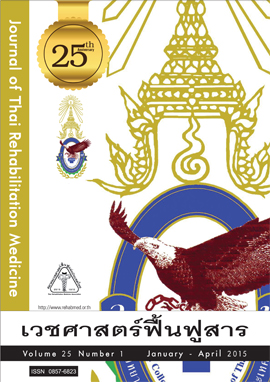คุณภาพชีวิตของผู้ป่วยบาดเจ็บไขสันหลังจากอุบัติเหตุใน ภาคตะวันออกเฉียงเหนือของประเทศไทย
Keywords:
คุณภาพชีวิต, บาดเจ็บไขสันหลัง, รายได้, การประกอบอาชีพ, ระดับรอยโรคไขสันหลัง, quality of life, spinal cord injury, depressionAbstract
Quality of Life of Traumatic Spinal Cord Injured Patients in North-East Region of Thailand
Choochart N, Vichiansiri R, Arayawichanon P, Manimmanakorn N
Department of Rehabilitation Medicine, Faculty of Medicine, Khon Kaen University
Objectives: To study the quality of life (QOL) and factors affecting QOL of the traumatic spinal cord injured (SCI) patients.
Study design: Cross-sectional descriptive study Setting: Department of Rehabilitation Medicine, Srinagarind Hospital.
Subjects: Traumatic SCI patients, aged 18-60 years, who received treatment from Department of Rehabilitation Medicine, Srinagarind Hospital.
Methods: The SCI patients were interviewed. Their demographic data and the Spinal Cord Independence Measure II (SCIM II) were recorded. They were asked to complete the WHOQOL–BREF–THAI quality of life questionnaire, the Khon Kaen University Depression Inventory (KKU-DI).
Results: We included 53 SCI patients, aged 42.72 (SD 12.24) years, ranged 18-60 years, and 42 males (75%). Fifteen patients (28.3%) had cervical, 27 (50.9%) thoracic and 11 (20.8%) lumbar lesions. The average SCIM II score was 55.16 (SD 25.39). According to the KKU-DI, 22 (41.5%) had depressive disorder. Overall WHOQOL-BREF-THAI score was 74.51 (SD 12.05), reflecting moderate level of QOL. The QOL scores of physical, psychological, social relationships, environmental and overall were 20.51 (SD 4.49), 19.75 (SD 3.66), 8.74 (SD 1.98), 25.51 (SD 4.37) respectively. Factors significantly related to QOL were income, occupation and level of injury.
Conclusion: The overall quality of life of traumatic spinal cord injured patients was moderate. The factors affecting QOL included income, occupation and level of injury.
บทคัดย่อ
วัตถุประสงค์: เพื่อศึกษาคุณภาพชีวิตของผู้ป่วยบาดเจ็บไข สันหลัง และปัจจัยที่มีผลต่อคุณภาพชีวิตของผู้ป่วยบาดเจ็บ ไขสันหลังจากภาคตะวันออกเฉียงเหนือ ที่มารับการรักษาตัวที่ โรงพยาบาลศรีนครินทร์
รูปแบบการวิจัย: การศึกษาเชิงพรรณนาแบบภาคตัดขวาง สถานที่ทำการวิจัย: ภาควิชาเวชศาสตร์ฟื้นฟู โรงพยาบาล ศรีนครินทร์ กลุ่มประชากร: ผู้ป่วยบาดเจ็บไขสันหลังจากอุบัติเหตุ อายุ ระหว่าง 18-60 ปี และเคยรับการรักษาที่ภาควิชาเวชศาสตร์ ฟื้นฟู โรงพยาบาลศรีนครินทร์
วิธีการศึกษา: สัมภาษณ์และเก็บข้อมูลทั่วไปของผู้ป่วย, ใช้ WHOQOL-BREF ฉบับภาษาไทยประเมินคุณภาพชีวิต, ใช้แบบ ประเมิน KhonKaen University Depression Inventory (KKU-DI) เพื่อประเมินภาวะซึมเศร้า และใช้แบบประเมิน Spinal cord independence measure ฉบับปรับปรุงครั้งที่ 2 (SCIM II) เพื่อประเมินความสามารถในการประกอบกิจวัตร ประจำวันของผู้ป่วย
ผลการศึกษา: ผู้ป่วยจำนวน 53 คน อายุ 18- 60 ปี อายุเฉลี่ย (ส่วนเบี่ยงเบนมาตรฐาน) 42.72 (12.24) ปี, 42 คน (ร้อยละ 79) เป็นเพศชาย. ร้อยละ 28.3 มีรอยโรคไขสันหลังที่ระดับคอ, ร้อยละ 50.9 ที่ระดับทรวงอก และ ร้อยละ 20.8 ที่ระดับเอว. คะแนนเฉลี่ยความสามารถในการประกอบกิจวัตรประจำวัน (SCIMII) เท่ากับ 55.16 (25.39). ร้อยละ 41.5 มีภาวะซึมเศร้า. ค่าเฉลี่ยคุณภาพชีวิตโดยรวม (ส่วนเบี่ยงเบนมาตรฐาน) เท่ากับ 74.51 (12.05) บ่งชี้คุณภาพชีวิตระดับปานกลาง ทั้งนี้ ด้าน ร่างกาย เท่ากับ 20.51 (4.49), ด้านจิตใจ เท่ากับ 19.75 (3.66), ด้านความสัมพันธ์ทางสังคม เท่ากับ 8.74 (1.98) และ ด้านสิ่งแวดล้อม เท่ากับ 25.51 (4.37). ส่วนปัจจัยที่มีความสัมพันธ์กับคุณภาพชีวิตอย่างมีนัยสำคัญ ได้แก่ รายได้ การ ประกอบอาชีพ และระดับรอยโรคไขสันหลัง
สรุป: ผู้ป่วยบาดเจ็บไขสันหลังจากภาคตะวันออกเฉียงเหนือ ที่เข้ารับการรักษาและฟื้นสภาพที่โรงพยาบาลศรีนครินทร์ มี คุณภาพชีวิตอยู่ในระดับปานกลาง โดยปัจจัยที่มีผลต่อคุณภาพ ชีวิต ได้แก่ รายได้, การประกอบอาชีพ และระดับรอยโรคไขสันหลัง






